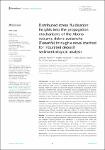Distributed stress fluidisation: insights into the propagation mechanisms of the Abona debris avalanche (Tenerife) through a novel method for indurated deposit sedimentological analysis
| dc.contributor.author | Makris, Symeon | |
| dc.contributor.author | Roverato, M | |
| dc.contributor.author | Davila-Harris, P | |
| dc.contributor.author | Cole, Paul | |
| dc.contributor.author | Manzella, Irene | |
| dc.date.accessioned | 2023-05-25T15:24:18Z | |
| dc.date.available | 2023-05-25T15:24:18Z | |
| dc.date.issued | 2023-05-18 | |
| dc.identifier.issn | 2296-6463 | |
| dc.identifier.issn | 2296-6463 | |
| dc.identifier.other | ARTN 1177507 | |
| dc.identifier.uri | https://pearl.plymouth.ac.uk/handle/10026.1/20935 | |
| dc.description.abstract |
Introduction: Volcanic debris avalanches mobilise large volumes and achieve long runouts with high destructive potential. However, the propagation processes that generate them are not currently explained by theoretical or numerical models, which are unable to represent deposit observations. Evaluation of the dynamics represented in deposits is therefore vital for constraining su ch models. The Abona volcanic debris avalanche deposit is located on the southern flank of the island of Tenerife, Spain. The deposit exhibits universal microfracturing and cataclasis. Fluidal features such as fluidal mixing of lithological units and diffuse boundaries, and mixed matrix are observed throughout the deposit. Methods: Field description including sedimentology and facies identification and the evaluation of their distribution have allowed the generation of a new conceptual model for the propagation dynamics of this volcanic debris avalanche, and potentially others with similar properties. The deposit is indurated making the detailed study of its sedimentology difficult, especially clast-size analysis. A novel method utilising structure from motion photogrammetry and photographic sampling was employed. Results: The universal cataclasis of the material and fluidal features suggest that the lack of a major competent material component allowed the mass to fragment and enabled fluidised granular flow behaviour. It is proposed that shear was periodically distributed throughout the body of the avalanche in chaotic temporary shear networks rearranging according to the instantaneous distribution of the mass. Stress and agitation were not temporally or spatially homogenous during propagation. This is also reflected in the unsystematic erosion of the substrate according to the variable basal shear accommodation. Discussion: It is proposed that lithological properties are potentially a determining factor for the propagation mechanisms, stress distribution, and consequently the evolution of a volcanic debris avalanche from the initial collapse to its emplacement. This study highlights the importance of dedicated field examinations of sedimentological, morphological, and structural features for providing constraints for models of volcanic debris avalanche dynamics and the factors dictating them. The novel methodology proposed has the potential of broadening the number of events that can be studied and enhancing the understanding of these complex and hazardous phenomena. | |
| dc.format.extent | 1177507- | |
| dc.publisher | Frontiers Media | |
| dc.subject | volcanic debris avalanche | |
| dc.subject | sedimentology | |
| dc.subject | propagation dynamics | |
| dc.subject | clast-size analysis | |
| dc.subject | indurated | |
| dc.subject | photogrammetry | |
| dc.subject | facies | |
| dc.subject | granular temperature | |
| dc.title | Distributed stress fluidisation: insights into the propagation mechanisms of the Abona debris avalanche (Tenerife) through a novel method for indurated deposit sedimentological analysis | |
| dc.type | journal-article | |
| dc.type | Journal Article | |
| plymouth.author-url | https://www.webofscience.com/api/gateway?GWVersion=2&SrcApp=PARTNER_APP&SrcAuth=LinksAMR&KeyUT=WOS:001000254900001&DestLinkType=FullRecord&DestApp=ALL_WOS&UsrCustomerID=11bb513d99f797142bcfeffcc58ea008 | |
| plymouth.volume | 11 | |
| plymouth.publication-status | Published online | |
| plymouth.journal | Frontiers in Earth Science | |
| dc.identifier.doi | 10.3389/feart.2023.1177507 | |
| plymouth.organisational-group | |Plymouth | |
| plymouth.organisational-group | |Plymouth|Faculty of Science and Engineering | |
| plymouth.organisational-group | |Plymouth|Faculty of Science and Engineering|School of Geography, Earth and Environmental Sciences | |
| plymouth.organisational-group | |Plymouth|REF 2021 Researchers by UoA | |
| plymouth.organisational-group | |Plymouth|Users by role | |
| plymouth.organisational-group | |Plymouth|Users by role|Academics | |
| plymouth.organisational-group | |Plymouth|Users by role|Post-Graduate Research Students | |
| plymouth.organisational-group | |Plymouth|REF 2021 Researchers by UoA|UoA07 Earth Systems and Environmental Sciences | |
| dcterms.dateAccepted | 2023-05-05 | |
| dc.date.updated | 2023-05-25T15:24:09Z | |
| dc.rights.embargodate | 2023-5-26 | |
| dc.identifier.eissn | 2296-6463 | |
| dc.rights.embargoperiod | forever | |
| rioxxterms.versionofrecord | 10.3389/feart.2023.1177507 |


